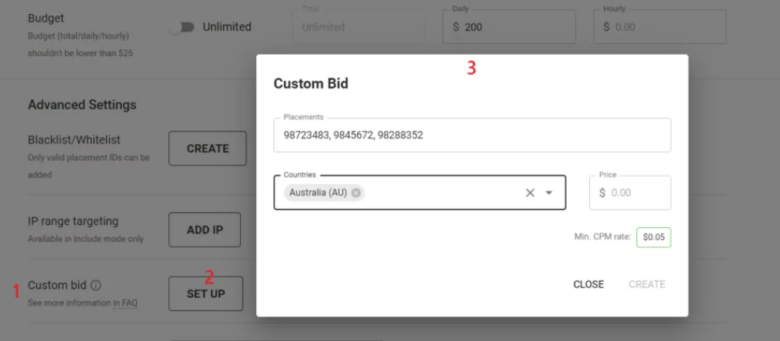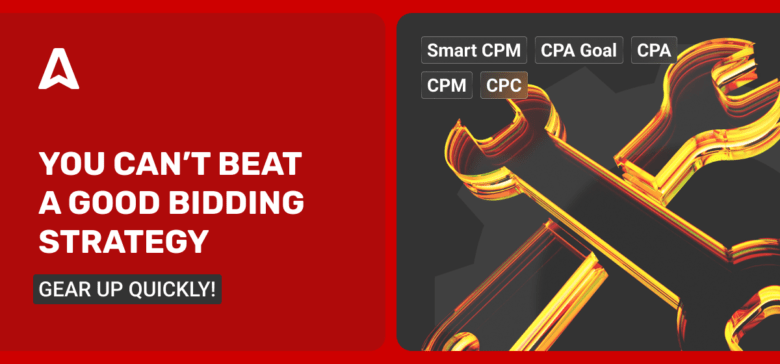Actually, you can beat a good bidding strategy if you play it even smarter with the right tools. Jokes aside, let’s do a safety check. What is a bid strategy? How do you choose and develop it? How do you measure your results?
In this article, we’ll also spot the blind zones and challenges of the bid-effective strategy and get expert advice from the Head of CPA and the Head of CPM Departments at Adsterra.
Let’s plunge in!
What is a bid strategy?
It’s a structured plan or approach that advertisers use to decide how much to spend on advertising placements or targeted user’s actions.
A bid strategy gears up advertisers to compete for valuable ad space and set bids based on their goals, budgets, and desired outcomes. It’s commonly employed on platforms like Google Ads (Google Display Network), Bing Ads, Facebook and other social media networks, or ad networks like Adsterra.
Types of bid strategies
As you can guess, there exist a few approaches how to strategize the bidding process that influence the overall campaign performance.
Among them are automated bid strategies, manual bidding strategies, ad spend optimization, smart bidding strategies, manual CPC bidding or CPM bidding, and other price-model ways.
Bid adjustments, accurate prediction, keyword bids, and multiple campaigns are among the approaches you can use too. That said, you can mix them for different ad platforms and commit to your particular strategy while bidding.
Let’s look into the key strategies for automatic and manual bidding:
Cost-per-click (CPC): Advertisers pay when a user clicks on the advert. It works great to gain traffic for your offer on a website or landing page and is measured by clicks.
Cost-per-mille (CPM): Advertisers pay a cost per thousand impressions their ads get. Here, users’ actions are not the focus. It’s effective for brand awareness campaigns and ads’ visibility.
Cost-per-acquisition (CPA): Advertisers pay for every user’s action. It can be an app installment, sign-up, purchase, form fill-in, etc. It’s applicable when your bid-based strategy focuses on conversions.
Target return on ad spend (ROAS): Advertisers aim at a targeted return on advertising. It works well in niches where the conversion value bidding can be easily calculated.
Is it better to use manual or automated bid strategy?
If you are starting out with ad strategies and bidding, you can try the manual vs automated bid strategy. Here, you monitor your ad performance, adjust manual bids, target cost, and ad spend by hand, and have total control of your ad campaign.
As you go, you’ll soon find yourself at the next level. The automated bid strategy based on smart technologies is as simple and saves you tons of time. It employs new algorithms and is way too effective to miss out.
How to сhoose a bidding strategy or develop a new one?
Advertisers can use general factors to consider or re-consider the approach to advertising bids:
Determine your goals: Is it all about brand awareness campaigns, clicks, conversions, or other users’ actions?
Research your competitors. There are tools that can help you optimize your bidding amounts and overall strategy according to those of your competitors. And you only pay just slightly more. We’ll dive into that tactic in detail below.
Allocate your budget. Watch your entire budget for both your campaign and the daily spend. You can do it automatically on some platforms by applying daily caps.
Feel your audience. Adjust creatives, language, message, targeting settings, and traffic source for your campaign.
Look into ad platforms or networks. Check what tools, aka capabilities, your advertising platform has for bidding to complement your strategy.
Test, rinse, repeat. It works for data-driven advertising in general and in strategies created for bidding. Receive insights, refine targeting, optimize your ad campaigns, and step up further!
Choose an ad platform with the most skillful and advanced approach while strategizing your bidding. With Adsterra, you have a set of tested tools, granular targeting options, and quality global traffic to direct to your ads.
How does bidding strategy work?
Here is an example of how to make it work within Adsterra. You can register an Advertiser’s account for free without a deposit to have a look around first, which is not a bad strategy on its own.
To get started on an actual ad campaign, you need the following:
- Sign up or log in as an Advertiser.
- Click Create campaign.
- Implement bid targeting settings (aka modifiers) like operating system, device, country, region, or even city, traffic source, etc.
- Choose a pricing model (CMP, CPA, CPC).
- Choose suitable ad formats from Social Bar Ads, In-Page Push, Popunder, and Interstitial.
- Apply S2S Tracking of your choice and get a postback for granular monitoring of your ad campaigns.
- Apply helping tools like Smart CPM, Custom Bid, CPA Goal, etc.
- Go flexible with blacklists, whitelists, and graylists since traffic can change.
- In a few days, stop your campaign and run a report. Make sure to measure the CTR, sign-ups, and conversions. Optimize bids and overall strategy accordingly.
Expert tip
It’s a viable approach to start with medium bids and increase to the top values as you gradually optimize your ad campaigns. You will maximize your conversions if you are in the range of medium to high bids.
Steps to implement a bid strategy effectively
Adsterra recommends a few must-have tools to its Partners. After a few technicalities, you automate your strategy for bidding and traffic acquisition that takes a lot of weight off your shoulders. Let’s explore the tools we recommend, zoom them in and keep close at hand. Among them are:

With new smart technologies, you don’t need to use the bidding-with-eyes-closed strategy. On the contrary, you have the data at your fingertips to lean on. You can pay a little more than your next competitor without paying the highest price to win traffic within your auction time bidding. It’s also known as the second-price auction algorithm that automatically sets you for the smartest bids without overspending.
Expert tip
When working with CPM, you should always consider your daily and total limits for your ad campaign budget. The even budget distribution during the periods will serve as a good basis for further campaign optimization.
CPA Goal is a state-of-the-art tool for growing conversions at an affordable CPM or CPC price. Advertisers can select traffic and target the number of conversions they can get with the entire budget. That is turning quantity into quality, and again you are kept safe from excessive ad spend.
Create your rules that will verify traffic and sort the best slices on the fly. Once a placement stops complying with your rules, it will be unlinked automatically.

Head of CPA
at Adsterra
Expert tip
When working with CPM, you should always consider your daily and total limits for your ad campaign budget. The even budget distribution during the periods will serve as a good basis for further campaign optimization.

It’s one more workable tool to set bids effectively and boost your bidding process strategy. Within your account, there is an option to set up the S2S (server-to-server) tracking that will accumulate all the vital metrics for launching effective ad campaigns.
After that, Adsterra will start tracking ad placements performance and providing you with data. You’ll be able to track your placements performance and decide whether you are ready to secure strategy and invest more in bidding.
With these tools, you can hone your strategy and automate bids for ad placements without overspending budget and time. Even in niches with high-costs customer acquisition and long lifetime value (LTV).
Typical bid strategy challenges and solutions to tackle them
Be aware of possible strategy challenges on your way to effective bidding and note how you can find sustainable workarounds:
Cost Uplifts. Depending on competition, your target cost can fluctuate. Ongoing tests and optimization can help your ROI math add up.
Algorithms updates. It can’t be helped really. The only way here is to stay on top of things, and be flexible to maneuver as a good surfer.
Ad creatives optimization. Double-check that you can kick off your bidding and creative strategy with smart ad groups of creatives, so you can test and select the ones best for your CTR.
Low CR. Even if your bidding strategy is a winner, make sure your web page with your offer is well-optimized to convert. Take care of appealing copy, CTAs (call-to-actions), proper landing page loading time, etc.
Budget Drains. Literally take your time spending your advertising budget. Check up your bids daily, weekly, or per global calendar events.
Targeting settings. Investigate all the options you have up your sleeve within your ad platform, you can do it in advance to see if it’s enough. Registration is usually free.

Head of CPA
at Adsterra
Expert tip
If you see that your CPA campaign is losing volumes it’s wise to consider increasing your rate. Since Adsterra is eCPM based auction, your aim is high eCPM, when chasing high traffic volumes. You can achieve it by increasing rates or your CR. If you can’t increase on all placements overall, check if any of our sources stand out in terms of your ROI and Custom Bid instead.
How to measure your bid-based strategy?
To measure and optimize your bid-based strategy accordingly, you can harness Return on Ad Spend (ROAS) that tracks revenue in correlation to a dollar spent on advertising.
You can utilize Quality Score on Google Ads campaigns and similar platforms that evaluate the relevance and quality of ads and keywords.
Click-through rate (CTR) highlights the offer’s relevance to your audience, while Conversion Rate (CR) measures the number of desired actions.
Your flow can cover a range of key performance indicators (KPIs) that you apply to your bid-focused strategy.
Conclusion
Try and test several approaches and ad creatives to maximize conversions. Check out different ad platforms like Google Ads, advertising on social media platforms, and ad networks. Only by testing and being well-equipped for bidding, you can secure your strategy to high ROI and meet your KPIs.
You can easily tap into the best practices that Adsterra offers to its Partners. These are 248+ GEOs, high-quality traffic from 36K+ publishers, 3-level anti-cheat security, 20+ targeting options for strategic bidding and advertising, and much more.
Be sure to let us know if something we haven’t touched upon. Please drop a line to our Partner Care support team through a live chat if you have any questions about your bidding strategy.

